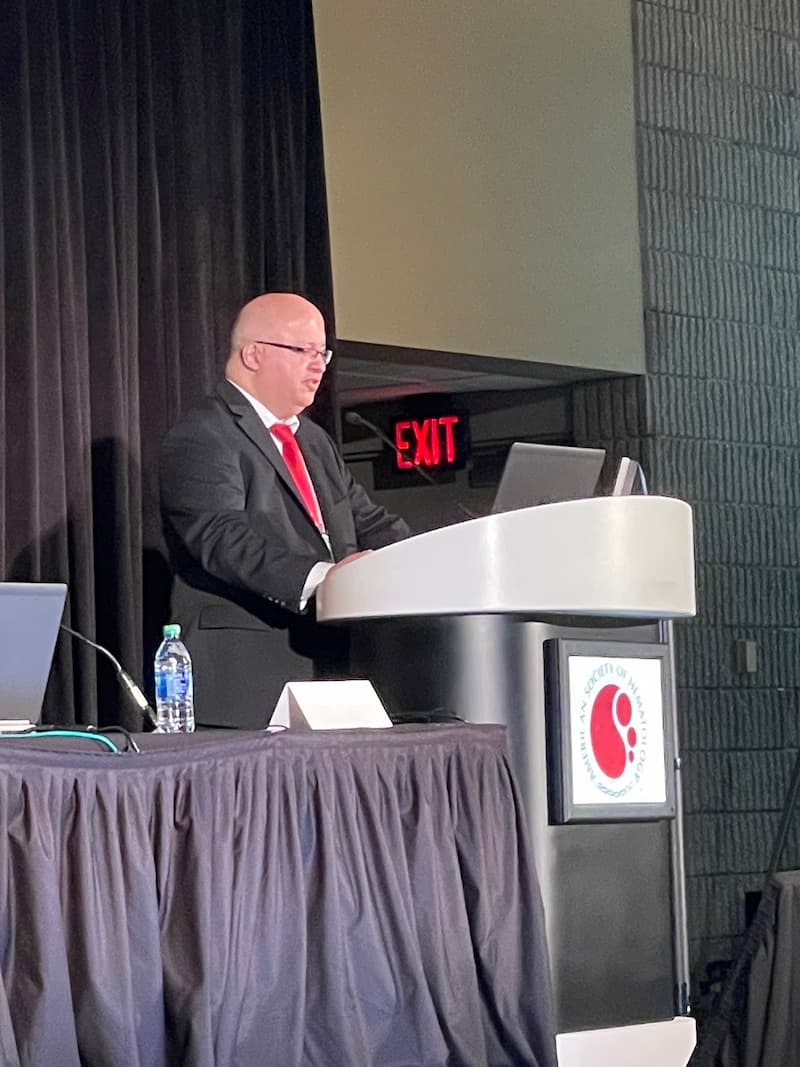MRD-Adapted Therapy Approach May Allow for Treatment-Free Surveillance in Certain Patients With Newly Diagnose Myeloma
Among patients with newly diagnosed multiple myeloma, 80% of a study cohort reached MRD negativity following treatment with daratumumab, carfilzomib, lenalidomide, and dexamethasone.
Luciano J. Costa, MD, PhD, presents data from the phase 2 MASTER trial at the 63rd American Society of Hematology Annual Meeting & Exposition.

Testing for minimal residual disease (MRD) using next-generation sequencing (NGS) was feasible for informing physicians about the use and duration of daratumumab (Darzalex) in combination with carfilzomib (Kyprolis), lenalidomide (Revlimid), and dexamethasone (Dara-KRd) following autologous transplant (AHCT) in patients with newly diagnosed multiple myeloma, according to data from the phase 2 MASTER Trial (NCT03224507).1
NGS-MRD response-adaptive therapy is feasible in approximately 96% of the patients in a multicenter setting, with 71% of the patients reaching MRD-SURE [treatment-free observation and MRD surveillance],” explained Luciano J. Costa, MD, PhD, associate director for clinical research at the O’Neal Comprehensive Cancer Center at University of Alabama at Birmingham, during a presentation of the results at the 63rd American Society of Hematology Annual Meeting and Exposition.
“Patients with standard and high-risk newly diagnosed myeloma have similar depth of response, and low-risk MRD resurgence or progression when treated with this regimen including MRD-adapted treatments.”
In the MASTER trial, Costa and colleagues aimed to determine the rate of MRD-negative responses using NGS in patients treated with Dara-KRd, ACHT, and MRD response-adapted Dara-KRd consolidation therapy. Secondary end points were toxicity of the combination regimen, conventional International Myeloma Working Group response, and outcomes of observation without maintenance therapy following MRD-negative responses. The investigators also aimed to determine MRD-negative rates by NGS with a threshold of 10-6 as an exploratory end point.
“Importantly, MRD was tested on ‘first pull’ fundamental aspects and reported that utilizing intent-to-treat principle, according to international harmonization,” Costa added.
Patients were treated with 16 mg/kg intravenous (IV) daratumumab on days 1, 8, 15, and 22; 56 mg/m2 IV carfilzomib on days 1, 8, and 15; 25 mg lenalidomide on days 1 through 21; and 40 mg dexamethasone on days 1, 8, 15, and 22, which was repeated every 28 days. According to MRD status, patients received 4 cycles of Dara-KRd as induction, followed by AHCT, and then received 0, 4, or 8 cycles of Dara-KRd consolidation therapy.
Dara-KRd was administered until achievement of 2 consecutive MRD-negative responses, defined as 10-5. Those with confirmed MRD-negativity then underwent treatment-free observation and MRD surveillance, or MRD-SURE. Surveillance was done 6 months after treatment ended, and yearly thereafter. For those who received consolidation therapy without confirmed MRD-negativity, maintenance therapy with lenalidomide was given.
In total, 123 patients were enrolled across 5 sites, of whom 118 (96%) had trackable MRD. Median follow-up was 23.8 months.
The majority of patients were male (57%), White (76%), and had an ECOG performance status of 0 or 1 (80%). Median age was 60 years (range, 35-79).
In the study, 53 patients (43%) had no high-risk chromosome abnormality (HRCA [gain/amp 1q, t(4;14), t(14;16), t(14;20) or del(17p)]; standard-risk), 46 (37%) had 1 HRCA (high-risk), and 24 (20%) had 2 or more HCRA (ultra-high risk).
Among all patients, 80% achieved MRD negativity after MRD-directed consolidation therapy, including 78% of those with standard-risk, 82% of those with high-risk, and 79% of those with ultra–high risk disease. Per the exploratory end point of the trial, 66% of patients achieved MRD negativity 10-6 following MRD-directed consolidation therapy, including 64%, 73%, and 58% of the standard-, high-, and ultra-high–risk groups, respectively.
In addition, MRD negativity was reached in 38% of patients after induction therapy and 65% of patients after AHCT. “The proportion of patients reaching MRD-negativity increases with each phase of therapy with a substantial gain,” Costa said.
Following cycle 4 of post-induction therapy, 88% of patients experienced a very good partial response (VGPR), which improved to 98% after MRD-adapted consolidation therapy.
The 2-year progression-free survival rates in the standard-, high-, and ultra-high–risk groups were 91%, 97%, and 58%, respectively (P < .001). Similarly, the overall survival rates in those groups were 96%, 100%, and 76%, respectively (P = .003).
In total, 84 patients achieved MRD-SURE, including 62% in the standard risk group, 78% in the high-risk group, and 63% in the ultra–high risk group. Median follow-up with MRD-SURE was 14.2 months.
The risk for MRD resurgence or progression at 12 months following the end of treatment was 4% in the standard risk group, 0% in the high-risk group, and 27% in the ultra-high–risk group.
Of note, no patients who entered MRD-SURE died from myeloma progression.
Grade 3 or higher adverse events (AEs) occurred in 91 patients (74%). Twenty-five treatment-emergent serious AEs were reported, including pneumonia (n = 8), pulmonary embolism (n = 3), fever and neutropenia (n = 2), atypical hemolytic uremic syndrome (n = 1), infusion-related reaction (n = 1), atrial fibrillation (n = 1), and other (n = 9). Three deaths occurred.
“Quadruple therapy and achievement of confirmed MRD-negative responses enables the exploration of treatment cessation and MRD-SURE as an alternative to continuous therapy,” Costa concluded. “And importantly, effective novel consolidation strategy should be explored to clear MRD and improve outcomes in patients with ultra-high–risk multiple myeloma.”
References
- Costa LJ, Chhabra S, Callander NS, et al. Daratumumab, carfilzomib, lenalidomide and dexamethasone (Dara-KRd), autologous transplantation and MRD response-adapted consolidation and treatment cessation. final primary endpoint analysis of the MASTER trial. Presented at: 2021 ASH Annual Meeting and Exposition; December 11-14, 2021; Atlanta, Georgia. Abstract 481. https://bit.ly/3EQZSLo
- Costa LJ, Chhabra S, Medvedova E, et al. Daratumumab, carfilzomib, lenalidomide and dexamethasone (Dara-KRd), autologous transplantation and MRD response-adapted treatment duration and cessation in newly diagnosed Multiple Myeloma (NDMM). Clinical Lymphoma Myeloma and Leukemia. 2021;21(2):S33. doi:10.1016/S2152-2650(21)02125-X
Newsletter
Stay up to date on recent advances in the multidisciplinary approach to cancer.